|
|
|
Sort Order |
|
|
|
Items / Page
|
|
|
|
|
|
|
| Srl | Item |
| 1 |
ID:
114672
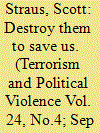

|
|
|
|
|
| Publication |
2012.
|
| Summary/Abstract |
Based on an analytic review of recent scholarly advances in genocide studies, this article investigates the causes, concept, and logic of genocide while suggesting a set of theoretical propositions and avenues for future research. Two emerging theoretical streams of literature on causes-strategic and ideological-highlight different dimensions of genocide and should be thought of as compatible. The study of genocide should be embedded in a broader study of political violence; the two literatures have been strangely cloistered from each other. To that end, genocide should be conceptualized as group-selective, large-scale violence whose purpose is group destruction. This stands in contrast to violence that is individually selective or indiscriminate; small-scale and not sustained across time and space; and whose purpose is repression, communication, or some other outcome short of group destruction. To develop existing theory and to bring the study of genocide closer to the literature on violence, studying variation in outcomes is essential; that is, students of genocide should ask why genocide and not another outcome occurs, rather than only studying common patterns among genocide cases. Similarly, rather than study primarily sources of escalation and accelerators of violence, scholars should also theorize restraint and decelerators of violence. Further, scholars of genocide should focus attention on the interaction between national and sub-national actors as well as periods of escalation or de-escalation. In these ways and others proposed in the essay, genocide studies can build on recent gains and develop a broader and more coherent field of theoretical inquiry.
|
|
|
|
|
|
|
|
|
|
|
|
|
|
|
|
| 2 |
ID:
192656
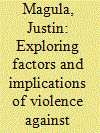

|
|
|
|
|
| Summary/Abstract |
The Soviet-Afghan War serves as a significant case study to understand why states resort to violent acts against civilians during war. This study takes a multidimensional approach, examining strategic, operational, and individual factors and applying theories of violence and mass killing. By analyzing the conditions that led the Soviets to target civilians, this investigation identifies a nexus of interconnected factors. At the strategic level, Soviet leaders pursued a swift victory to establish a Communist client regime while minimizing casualties and controlling information flow. Operationally, the ill-preparedness of the Red Army for counterinsurgency warfare, coupled with an entrenched organizational culture, led to the adoption of counterproductive enemy-centric tactics against Afghan noncombatants. Additionally, inadequate training, prolonged deployments, and a lack of disciplinary measures at the individual level contributed to the perpetration of violent acts. Understanding the underlying causes of violence against civilians, particularly in the context of Russian forces, holds practical importance. This knowledge can assist policymakers in devising strategies that mitigate wartime violence and enhance the protection of citizens. Drawing parallels to contemporary conflicts involving Russia, the study concludes by recommending future research directions and emphasizing the relevance of comprehending the targeting of noncombatants in ongoing conflicts, notably the Russian-Ukrainian conflict.
|
|
|
|
|
|
|
|
|
|
|
|
|
|
|
|
| 3 |
ID:
157362
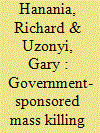

|
|
|
|
|
| Summary/Abstract |
Why do civil wars reoccur? Some scholars emphasize the role of post-war factors, while others locate the causes of civil war recurrence in the dynamics of the conflicts themselves. We build a theory that bridges these arguments by focusing on mass killing. We argue that government mass killing during war reduces opportunities for the opposition to return to military conflict in the future. This allows for longer periods of post-conflict peace. However, government atrocities that begin after the end of a civil war create new grievances without diminishing the ability of opponents to fight. This makes a faster return to conflict more likely. Statistical analysis of all civil wars between 1946 and 2006 strongly supports our arguments, even when we account for selection effects regarding when governments are more likely to engage in mass killing. These results reveal that both during-war and post-war tactics influence civil war recurrence, but that the same tactic can produce different effects depending on the timing of its use.
|
|
|
|
|
|
|
|
|
|
|
|
|
|
|
|
| 4 |
ID:
167280
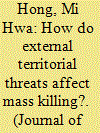

|
|
|
|
|
| Summary/Abstract |
The current scholarship on mass killing demonstrates that genocide and other forms of mass murder are usually policy responses to threats, emphasizing armed conflict and political upheaval, such as revolution, as important causal factors. However, scholars have so far had little to say about the relationship between a country’s external threat environment and mass killing. We argue that a country’s external security environment, particularly when its neighbors pose threats to its territorial integrity, is a critical and understudied factor shaping a leader’s decision to employ mass killing. External territorial threats can produce domestic in-group/out-group dynamics, heightening fears that some domestic groups may be supporting or colluding with the enemy. Yet, given the availability of alternative policies and the enormous costs of mass killing, territorial threats alone do not suffice to explain why a state chooses mass killing over other types of violent or nonviolent strategies. Only when leaders are committed to exclusionary ideologies, are territorial threats more likely to catalyze hatred and fear of domestic out-groups, increasing a leader’s willingness to direct massive violence against them. Such leaders are more likely to frame domestic out-groups as inherently threatening and as enemies to be eliminated. Our empirical analysis reveals that a country’s territorial threat, measured by either territorial rivalries or territorial claims, is associated with a greater likelihood of mass killing onset only when leaders hold exclusionary ideologies.
|
|
|
|
|
|
|
|
|
|
|
|
|
|
|
|
| 5 |
ID:
160534
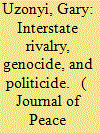

|
|
|
|
|
| Summary/Abstract |
Interstate rivalry not only influences a country’s international behavior, but also its domestic conduct. Here, I focus on the connection between interstate rivalry and domestic government mass killing, specifically genocide and politicide. I argue that interstate rivalry has both direct and indirect influences on a government’s decision to use mass violence against its civilian population. Directly, countries engaged in rivalry experience a heightened state of military tension, which increases the likelihood that the country will resort to political mass killing when handling domestic dissent. Indirectly, rivalry increases the likelihood of both inter- and intrastate conflict, which also increases the likelihood of genocide and politicide. Statistical analysis of all country-years from 1955 to 2011 reveals that interstate rivals are more likely to engage in genocide and politicide than are other states. This research illustrates the way in which interstate rivalry influences a state’s domestic politics and shapes the interactions between government and population. It also highlights the importance of how the international threat environment affects a state’s willingness to engage in domestic political mass murder. These findings indicate that rivals do not only engage in the most violent interstate behavior, but also some of the deadliest domestic politics, as well.
|
|
|
|
|
|
|
|
|
|
|
|
|
|
|
|
| 6 |
ID:
107968
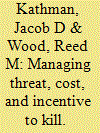

|
|
|
|
|
| Publication |
2011.
|
| Summary/Abstract |
How do third-party interventions affect the severity of mass killings? The authors theorize that episodes of mass killing are the consequence of two factors: (1) the threat perceptions of the perpetrators and (2) the cost of implementing genocidal policies relative to other alternatives. To reduce genocidal hostilities, interveners must address these factors. Doing so requires that interveners alter the genocidaire's expectation of a successful extermination policy, which in turn requires a demonstration of the third party's resolve. This cannot be achieved immediately upon intervention, and, given the perpetrator's strategic response to third-party involvement, the authors expect intervention to increase hostilities in the short term. With time, however, the authors contend that the characteristics of impartial interventions offer the greatest opportunity for reducing the violence in the long term. A statistical analysis of the 1955-2005 period supports the theoretical expectations.
|
|
|
|
|
|
|
|
|
|
|
|
|
|
|
|
| 7 |
ID:
133544
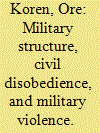

|
|
|
|
|
| Publication |
2014.
|
| Summary/Abstract |
In this article, I argue that factors inherent to the structure of a military organization and their relationship with the political leadership play a role in the organization's tendency to perpetrate violence against civilians during civil disobedience campaigns. To examine this hypothesis, I conducted a three-phased statistical analysis on a database containing 97 campaigns that took place between 1972 and 2012. In the first phase, I examined the relationship between military centric factors and violent crackdowns. In the second phase, I examined the relationship between military centric factors and mass killing. In the third stage, I examined the relationship between two specific types of discrimination in the military and mass killing. I found strong evidence supporting the hypothesis mentioned above. High-risk militaries that served a militarized regime, contained loosely regulated or indoctrinated paramilitaries, and discriminated against the protesting group, were much more likely to perpetrate violence against civilians during civil disobedience campaigns than low-risk militaries. The conclusions of this study suggest that further examination of the military's role in perpetrating violence against civilians during protests and conflict may provide some novel findings.
|
|
|
|
|
|
|
|
|
|
|
|
|
|
|
|
| 8 |
ID:
083230
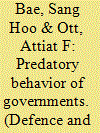

|
|
|
|
|
| Publication |
2008.
|
| Summary/Abstract |
In this paper we seek to answer the question: why do governments engage in mass killing? Tullock (1974) gives gain or avoidance of loss as the motive. We construct a three-stage theoretic framework to explain the choice of a ruler of a country. The conditions that must be met for a mass killing regime to win over alternative regimes are derived. Using the COW project data over the period 1816-1997, we estimate two models: negative binomial regression of number of battle-related deaths and a probit model for the choice of mass killing. The paper concludes with suggestions for data collections and further research.
|
|
|
|
|
|
|
|
|
|
|
|
|
|
|
|
| 9 |
ID:
079921
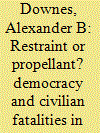

|
|
|
|
|
| Publication |
2007.
|
| Summary/Abstract |
This article investigates the effect of regime type on the number of civilian fatalities that states inflicted in interstate wars between 1900 and 2003. As opposed to several previous studies, the author finds little support for normative arguments positing that democracies kill fewer civilians in war. In fact, the author finds that democracies are significantly more likely than nondemocracies to kill more than fifty thousand noncombatants. Democracies also kill more civilians when they are involved in wars of attrition and kill about as many (and perhaps more) noncombatants than autocracies in such wars. These findings provide qualified support for institutional arguments about democratic accountability. Other implications of the institutional view, however, are not upheld, such as the argument that democracies select easy wars that should result in few civilian casualties because they are won quickly and decisively. Finally, democracies do not appear to kill fewer civilians in more recent wars
|
|
|
|
|
|
|
|
|
|
|
|
|
|
|
|
| 10 |
ID:
134992
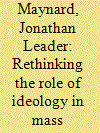

|
|
|
|
|
| Summary/Abstract |
There is a widespread sense amongst theorists of genocide and other violent atrocities that ideology matters. But in spite of this agreement all is not well with actual efforts to theorise ideology's role. Theoretical and empirical coverage has been uneven, and there has been little if any effort to incorporate theories and research from the actual specialist field of contemporary ideology studies. As a result, overarching theoretical accounts of the role ideology plays in violent atrocities remain limited and problematic. This article aims to encourage theorists to think about ideology in a more systematic and productive fashion by analysing four questions: (a) what do we mean by ideology?; (b) who, in cases of atrocity, might be relevantly affected by ideology?; (c) how do these people come to be influenced by atrocity-justifying ideologies?; and (d) how might ideology encourage these people to commit, or permit, mass violence? In discussing these four questions, I aim to clear up a number of misconceptions or vagaries that frequent current analyses of ideology in works on atrocity and political violence. I ultimately offer a suggestive account of six recurring “justificatory mechanisms” which collectively describe some of the common features of ideology's role across cases of mass atrocity.
|
|
|
|
|
|
|
|
|
|
|
|
|
|
|
|
| 11 |
ID:
155883
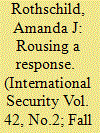

|
|
|
|
|
| Summary/Abstract |
When do U.S. presidents change policy to respond with increased intensity to mass killings of civilians in other countries? The twentieth century witnessed a series of state-sponsored mass killings in a variety of regions around the world. Conventional arguments suggest that although the United States has the capability of responding to such atrocities, it often fails to do so because of a lack of political will for action. Historical evidence suggests, however, that although the modal response of the United States is inaction, at times U.S. presidents reverse course to respond more forcefully to mass killings. Three factors explain when and why these policy shifts happen: the level at which dissent occurs within the U.S. government, the degree of congressional pressure for policy change, and the extent to which the case of mass killing poses a political liability for the president. President Franklin D. Roosevelt's creation of the War Refugee Board in 1944 during the Holocaust supports this theory.
|
|
|
|
|
|
|
|
|
|
|
|
|
|
|
|
| 12 |
ID:
157581


|
|
|
|
|
| Summary/Abstract |
Why do some civil wars feature the mass killing of civilians while others do not? Recent research answers this question by adopting a ‘varieties of civil war’ approach that distinguishes between guerrilla and conventional civil wars. One particularly influential claim is that guerrilla wars feature more civilian victimization because mass killing is an attractive strategy for states attempting to eliminate the civilian support base of an insurgency. In this article, I suggest that there are two reasons to question this ‘draining the sea’ argument. First, the logic of ‘hearts and minds’ during guerrilla wars implies that protecting civilians – not killing them – is the key to success during counterinsurgency. Second, unpacking the nature of fighting in conventional wars gives compelling reasons to think that they could be particularly deadly for civilians caught in the war’s path. After deriving competing predictions on the relationship between civil war type and mass killing, I offer an empirical test by pairing a recently released dataset on the ‘technology of rebellion’ featured in civil wars with a more nuanced dataset of mass killing than those used in several previous studies. Contrary to the conventional wisdom, I find that mass killing onset is more likely to occur during conventional wars than during guerrilla wars.
|
|
|
|
|
|
|
|
|
|
|
|
|
|
|
|
| 13 |
ID:
099851
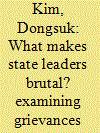

|
|
|
|
|
| Publication |
2010.
|
| Summary/Abstract |
What makes state leaders enmeshed in civil war commit mass killings against their own populations? This article explores this question by synthesizing grievances and mass killing. It investigates how factors or contexts that breed or exacerbate grievances can trigger state-sponsored mass killing during civil war. Severe political and economic marginalization and a history of intense armed conflict can engender staunch civilian support for insurgents, which prompts embattled rulers to orchestrate mass killing as a strategy of neutralizing insurgent combatants and warding off future rebellion. To verify this argument, a dataset is constructed that contains information on civil wars from 1945 to 2007 and large-N statistical analyses are conducted. The results corroborate the author's theoretical arguments with respect to political marginalization and history of armed conflict, but not with respect to economic marginalization. The argument and findings suggest that (1) grievances account for mass killing perpetrated by the government during civil war and (2) different sources of grievances have varying effects on mass killing.
|
|
|
|
|
|
|
|
|
|
|
|
|
|
|
|
|
|
|
|
|